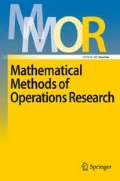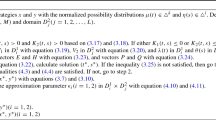Abstract
In this paper we consider the computation of Nash equilibria for noncooperative bi-matrix games. The standard method for finding a Nash equilibrium in such a game is the Lemke-Howson method. That method operates by solving a related linear complementarity problem (LCP). However, the method may fail to reach certain equilibria because it can only start from a limited number of strategy vectors. The method we propose here finds an equilibrium by solving a related stationary point problem (SPP). Contrary to the Lemke-Howson method it can start from almost any strategy vector. Besides, the path of vectors along which the equilibrium is reached has an appealing game-theoretic interpretation. An important feature of the algorithm is that it finds a perfect equilibrium when at the start all actions are played with positive probability. Furthermore, we can in principle find all Nash equilibria by repeated application of the algorithm starting from different strategy vectors.
Zusammenfassung
In diesem Beitrag entwickeln wir ein neues Verfahren zur Berechnung eines Nash-Gleichgewichtspunktes für Zweimatrizen-Spiele. Das Standardverfahren zur Lösung dieser Spiele ist der Lemke-Howson Algorithmus. Dieses Pivotverfahren löst ein lineares Komplementaritätsproblem. Da dieses Verfahren nur in einer beschränkten Anzahl Punkte beginnen kann, können nicht alle Gleichgewichtspunkte berechnet werden.
Unser Verfahren löst ein stationäres Punktproblem definiert auf die Strategiemenge und darf in einem beliebigen Punkt angefangen werden. Der Weg der Punkte des Algorithmus hat eine einladende spieltheoretische Interpretation. Wenn im Startpunkt alle Strategien mit positiver Wahrscheinlichkeit gewählt werden, dann ist das gefundene Nash-Gleichgewicht perfekt. Auch dürfen alle Gleichgewichtspunkte berechnet werden durch mehrere Startpunkte zu wählen.
Similar content being viewed by others
References
Bernhein D (1984) “Rationalizable strategic behaviour”, Econometrica 52: 1007–1028
van Damme EEC (1983) Refinements of the Nash Equilibrium Concept, Lecture Notes in Economics and Mathematical Systems 219, Springer Verlag Berlin
van den Elzen A (1990) “Interpretation and generalization of the Lemke-Howson algorithm”, Methods of Operations Research 60: 337–345
Lemke CE, Howson JT (1964) “Equilibrium points of bimatrix games”, SIAM Journal of Applied Mathematics 12: 413–423
Pearce D (1984) “Rationalizable strategic behaviour and the problem of perfection”, Econometrica 52: 1029–1040
Shapley LS (1974) “A note on the Lemke-Howson algorithm”, Mathematical Programming Studies 1: 175–189
Author information
Authors and Affiliations
Additional information
This research is part of the VF-program “Competition and Cooperation”, which has been approved by the Netherlands Ministery of Education and Sciences.
This author is financially supported by the Co-operation Centre Tilburg and Eindhoven Universities, The Netherlands.
Rights and permissions
About this article
Cite this article
van den Elzen, A.H., Talman, A.J.J. A procedure for finding Nash equilibria in bi-matrix games. ZOR - Methods and Models of Operations Research 35, 27–43 (1991). https://doi.org/10.1007/BF01415958
Received:
Revised:
Issue Date:
DOI: https://doi.org/10.1007/BF01415958



